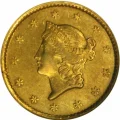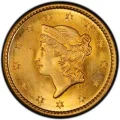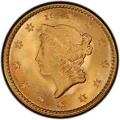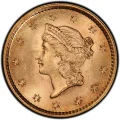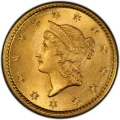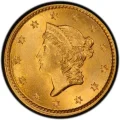- United States Coins
- Liberty Head Gold Dollar Coins
Liberty Head Gold Coins
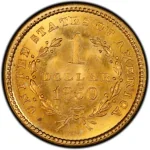 Gold was widely used in coins during the 18th century in the United States and was the basis of a dollar coin that was first minted in 1849. Liberty Head gold dollars, much like the concurrent silver dollars, circulated mainly in the West. These tiny, 13-mllimeter-wide gold coins were among the smallest U.S. coins ever made, measuring 1 millimeter smaller in diameter than the silver 3 cent coin of the same era.
Gold was widely used in coins during the 18th century in the United States and was the basis of a dollar coin that was first minted in 1849. Liberty Head gold dollars, much like the concurrent silver dollars, circulated mainly in the West. These tiny, 13-mllimeter-wide gold coins were among the smallest U.S. coins ever made, measuring 1 millimeter smaller in diameter than the silver 3 cent coin of the same era.
Liberty Head gold dollars were minted for a very short time, spanning from 1849 to 1854. During those six years, several eventual rarities were created, most of those coming from the Charlotte (C) and Dahlonega (D) mints, which often made less than 10,000 each of a given issue. The Philadelphia and New Orleans (O) mints also struck gold dollar coins, but those mintages were usually much larger than the productions from the Charlotte and Dahlonega mints. Therefore, Philadelphia and New Orleans gold dollars are far more common today than the C- or D-mint coins. In fact, those Philadelphia and New Orleans issues are generally worth $385 in lower circulated grades and go up in price from there, while the Charlotte and Dahlonega issues all boast values well over a thousand dollars.
In all, gold dollars are considerably scarce today, with often just a few hundred (or fewer) pieces surviving from any one of the scarcer issues. Weighing in at only 1.672 grams and containing just 0.4837 ounces of gold, Liberty Head gold dollars really are not regarded as high-priority items for bullion investors. Liberty Head gold dollars do have a very active collector base though, and they are widely sought after by collectors of 19th-century coinage and classic gold coins.
Below is a list of Liberty Head Gold Dollar info sheets for each year of issue. Each info sheet includes detailed pricing and mintage numbers for each variant.
-
{{#owner}}
-
{{#url}}
{{#avatarSrc}}
{{name}} {{/url}} {{^url}} {{#avatar}} {{& avatar}} {{/avatar}} {{name}} {{/url}} - {{/owner}} {{#created}}
- {{created}} {{/created}}

